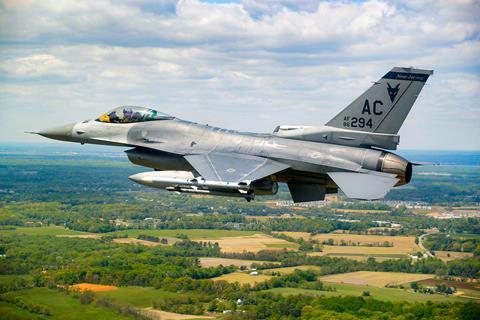The USA continues to signal reluctance on the issue of sending fighter jets to Ukraine, despite increasing support for the move in Europe.
Recent remarks from one of Washington’s top generals indicate the Pentagon and the Biden administration still have doubts about providing Lockheed Martin F-16 fighters to the Ukrainian air force (UAF). Kyiv’s armed forces have launched a much-anticipated counter-attack against Russian invaders.

“Conditions right now for the employment of the F-16s… they’re probably not ideal,” Lieutenant General Douglas Sims, operations director for the Pentagon’s joint staff, said on 13 July.
Sims’ comment came the same week as a NATO summit in Vilnius, Lithuania, during which a so-called “fighter coalition” of 11 European countries coalesced around the goal of providing Kyiv with the single-engined Lockheed jets.
The three-star general added that based on Pentagon assessments, Russia still has sufficient anti-air capability in Ukraine to prevent the advanced but-not-stealthy F-16s from achieving a significant battlefield impact.
“The Russians still possess some air defence capability. They have [air-to-air] capability,” Sims says. “The number of F-16s that would be provided may not be perfect for what’s going on right now.”
That view is likely to dampen optimism in Kyiv and other European capitals resulting from developments at the Vilnius summit, where there appeared to be progress on getting F-16s to Ukraine.
At the meeting, the fighter coalition announced, with tacit support from Washington, plans to begin training UAF pilots to fly F-16s in August. The arrangement will see Dutch and Danish aviators leading instruction for their Ukrainian counterparts, first in Denmark and later Romania.
However, the Biden administration has yet to provide a firm commitment to either allow European F-16 operators to transfer jets to Ukraine or to directly provide Kyiv with the long-sought equipment.
Under American law, Washington must approve sales and transfers of any US-made arms, including sales and transfers to third parties by existing operators, such as Denmark or the Netherlands. The Royal Danish Air Force operates 33 of the fourth-generation fighters, while the Royal Netherlands Air Force has 29 in its inventory, according to Cirium data.
While Washington will still require convincing, there is reason for optimism among supporters of the F-16 transfer.
Over 18 months of war, the Biden administration has repeatedly expressed initial reluctance to provide Ukraine with the most-powerful and sophisticated conventional weapon systems in America’s arsenal – such as air defence-systems and highly-accurate rocket artillery – before eventually relenting.
Amid criticism of the uneven approach, the administration has stood by its shifting policy stances, describing the changes as an evolution.
“The support has evolved over time, as the war has evolved,” US National Security Council communications coordinator John Kirby said on 20 May at the G7 summit in Hiroshima, Japan.
Kirby offered that explanation when Washington announced support for European allies’ request to offer F-16 flight training for Ukrainian pilots.
Sims also telegraphed willingness at the Pentagon to change the current stance if the battlefield situation in Ukraine evolves. “The conditions in the environment certainly are changing over time,” he says. “As the future changes, that certainly will dictate how [fighters] are employed.”
The USA has not provided detail about whether or how the Pentagon might be involved with the F-16 training effort.
“We do support those efforts and appreciate the leadership that Denmark and the Netherlands are providing on that front,” Pentagon press secretary Brigadier General Pat Ryder says.
The Danish defence ministry says the goal of the programme is to provide UAF aviators and support personnel with “basic skills and prerequisites to fly, service and maintain F-16 aircraft”.


























